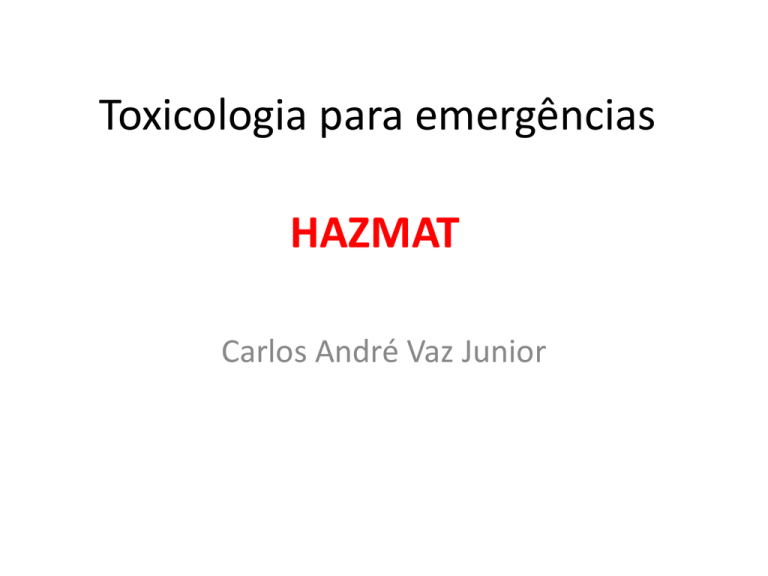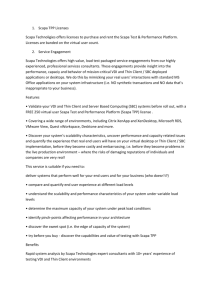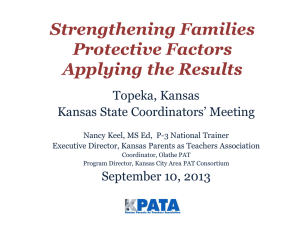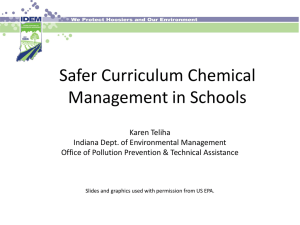Toxicologia para emergências
advertisement

Toxicologia para emergências HAZMAT Carlos André Vaz Junior Qual o nível de poluição aceitável? Métricas específicas para essas situações: http://www.aiha.org/insideaiha/GuidelineDevelopment/ERPG/Documents/ERPG_Values2010.pdf http://www.aiha.org/insideaiha/GuidelineDevelopment/ERPG/Documents/2011erpgweelhandbook_table-only.pdf Definições: The ERPG-1 is the maximum airborne concentration below which it is believed that nearly all individuals could be exposed for up to 1 hr without experiencing other than mild transient adverse health effects or perceiving a clearly defined, objectionable odor. The ERPG-2 is the maximum airborne concentration below which it is believed that nearly all individuals could be exposed for up to 1 hr without experiencing or developing irreversible or other serious health effects or symptoms which could impair an individual's ability to take protective action. The ERPG-3 is the maximum airborne concentration below which it is believed that nearly all individuals could be exposed for up to 1 hour without experiencing or developing lifethreatening health effects. AEGL: Acute Emergency Guideline Levels U.S. Environmental Protection Agency (EPA) Represent threshold exposure limits for the general public and are applicable to emergency exposures ranging from 10 minutes to 8 hours. Three levels— AEGL-1, AEGL-2, AEGL-3—are developed for each of five exposure periods (10 minutes, 30 minutes, 1 hour, 4 hours, and 8 hours) and are distinguished by varying degrees of severity of toxic effects. DOE guidance is to use the 1 hour AEGL values, which appear in this database. http://www.epa.gov/oppt/aegl/index.htm Definições: AEGL-1 is the airborne concentration (expressed as ppm [parts per million] or mg/m3 [milligrams per cubic meter]) of a substance above which it is predicted that the general population, including susceptible individuals, could experience notable discomfort, irritation, or certain asymptomatic, nonsensory effects. However, these effects are not disabling and are transient and reversible upon cessation of exposure. AEGL-2 is the airborne concentration (expressed as ppm or mg/m3) of a substance above which it is predicted that the general population, including susceptible individuals, could experience irreversible or other serious, long-lasting, adverse health effects or an impaired ability to escape. AEGL-3 is the airborne concentration (expressed as ppm or mg/m3) of a substance above which it is predicted that the general population, including susceptible individuals, could experience life-threatening adverse health effects or death. http://www.epa.gov/oppt/aegl/pubs/define.htm http://www.epa.gov/oppt/aegl/pubs/compiled_aegls_oct2010_v2.pdf TEEL: Temporary Emergency Exposure Limits SCAPA TEEL-0 is the threshold concentration below which most people will experience no adverse health effects. TEEL-1 is the airborne concentration (expressed as ppm [parts per million] or mg/m3 [milligrams per cubic meter]) of a substance above which it is predicted that the general population, including susceptible individuals, could experience notable discomfort, irritation, or certain asymptomatic, nonsensory effects. However, these effects are not disabling and are transient and reversible upon cessation of exposure. TEEL-2 is the airborne concentration (expressed as ppm or mg/m3) of a substance above which it is predicted that the general population, including susceptible individuals, could experience irreversible or other serious, long-lasting, adverse health effects or an impaired ability to escape. TEEL-3 is the airborne concentration (expressed as ppm or mg/m3) of a substance above which it is predicted that the general population, including susceptible individuals, could experience life-threatening adverse health effects or death. Diferenças entre os índices: There are subtle difference in the definitions of AEGLs, ERPGs, and TEELs and major differences in how they are developed and issued. Differences in their definitions include: AEGLs and TEELs pertain to the “general population, including susceptible individuals,” but ERPGs pertain to “nearly all individuals.” AEGLs and TEELs are defined as the level “above which” certain health effects are expected, while ERPGs are defined as the level “below which” certain health effects are not expected. ERPGs refer to exposure durations of 1 hour (with shorter periods for some chemicals). AEGLs are developed for five time periods (i.e., 10-minutes, 30-minutes, 1-hour, 4-hours, and 8-hours); the PAC database includes the AEGL 1-hour value. TEELs will be standardized on 1-hour in the near future. Mais detalhes: http://orise.orau.gov/emi/scapa/chem-pacs-teels/aegls-erpgs-teels.htm AEGLs and ERPGs are developed through a rigorous review of primary sources of toxicological information, and the values eventually assigned to each chemical are individually peer reviewed. ERPGs are formed using a weight of evidence approach. AEGLs are typically based on the results of a single key study. Both of these processes are painstaking and time-consuming. Additionally, AEGLs are subject to a public comment period and a further review by the National Academy of Science before being considered final. To produce limits in a more timely fashion while maintaining high quality, TEELs are derived from secondary data sources using a peer-reviewed algorithm. These sources are either existing exposure limits designed to prevent adverse effects in humans or experimentally derived toxicity parameters. It is important to emphasize that TEELs are considered temporary; they are approximations of potential values and are subject to change whenever new or better information becomes available. Additional information and reference links for AEGLs, ERPGs, and TEELs: AEGLs The U.S. EPA's AEGL Program has developed AEGLs to describe the risk to humans resulting from once-in-a-lifetime, or rare, exposure to airborne chemicals. The National Advisory Committee and National Research Council Committee on AEGLs are developing these guidelines to help both national and local authorities, as well as private companies, deal with emergencies involving spills, or other catastrophic exposures. The AEGL Program web site provides information on the scientific and policy work in developing AEGLs. http://orise.orau.gov/emi/scapa/chem-pacs-teels/aegls-erpgs-teels.htm AEGL Chemicals provides a searchable database of AEGL values, as well as a compiled listing of AEGL values. Because there can be a time lag between the release of new AEGLs and their incorporation in a revised PAC data set, please consult the AEGL website for the latest information on new AEGL releases. ERPGs The AIHA Emergency Response Planning Committee develops guidelines for responding to potential releases of airborne substances for use in community emergency planning. ERPGs are air concentration guidelines for single exposures to agents and are intended for use as tools to assess the adequacy of accident prevention and emergency response plans, including transportation emergency planning, community emergency response plans and incident prevention and mitigation. The AIHA Emergency Response Planning Committee website provides information on the development of ERPGs. ERPGs Levels for Select Chemicals (a PDF file) provides the official listing of ERPG values. Because there can be a time lag between the release of new ERPGs and their incorporation in a revised PAC data set, please consult the ERPG website for the latest information on new ERPG releases. http://orise.orau.gov/emi/scapa/chem-pacs-teels/aegls-erpgs-teels.htm TEELs In the early 1990s, the DOE Office of Emergency Operations recognized that ERPGs existed for only a limited number of chemicals (AEGL development did not start until later in the decade.) As a result, the DOE Office of Emergency Operations asked SCAPA for its recommendations on appropriate substitutes so that DOE facilities could conduct appropriate emergency preparedness hazard analyses (EPHAs) and perform consequence assessments. TEELs, first referred to as Alternative Guidelines Limits, were initially released in October 1992 and included values for approximately 65 chemicals. Today there are well over three thousand chemicals for which TEELs are used to provide one or more PAC values. The TEELs Method and Practices Handbook details the specific methods used to derive TEEL values. It also presents background information, sample calculations showing how TEELs are derived, and quality assurance measures used in the TEEL derivation process. A list of useful reference documents related to TEELs is provided by SCAPA. http://orise.orau.gov/emi/scapa/chem-pacs-teels/aegls-erpgs-teels.htm PAC: Protective Action Criteria for Chemicals (Chem PAC: Protective Action Criteria for Chemicals) DOE: Department of Energy Protective Action Criteria (PACs) are essential components for planning and response to uncontrolled releases of hazardous chemicals. These criteria, combined with estimates of exposure, provide the information necessary to evaluate chemical release events for the purpose of taking appropriate protective actions. During an emergency response, these criteria may be used to evaluate the severity of the event, to identify potential outcomes, and to decide what protective actions should be taken. These criteria may also be used to estimate the severity of consequences of an uncontrolled release and to plan for an effective emergency response. http://orise.orau.gov/emi/scapa/chem-pacs-teels/default.htm PAC: Protective Action Criteria for Chemicals (Chem PAC: Protective Action Criteria for Chemicals) Definição: PAC values for emergency planning for chemical release events are based on the following exposure limit values: AEGL: values published by the U.S. Environmental Protection Agency (EPA) ERPG: values produced by the American Industrial Hygiene Association (AIHA) TEEL: values developed by SCAPA http://orise.orau.gov/emi/scapa/chem-pacs-teels/default.htm PAC: Protective Action Criteria for Chemicals (Chem PAC: Protective Action Criteria for Chemicals) Definição: For any particular chemical, DOE policy for its facilities and activities established the following hierarchy of PAC values: Use AEGLs (including final or interim values) if they are available. If AEGLs are not available, use ERPGs. If neither AEGLs or ERPGs are available, use TEELs. http://orise.orau.gov/emi/scapa/chem-pacs-teels/default.htm PAC: Protective Action Criteria for Chemicals (Chem PAC: Protective Action Criteria for Chemicals) Definição: AEGLs, ERPGs, and TEELs have three common benchmark values for each chemical (i.e., PAC-1, -2, and -3). Each successive benchmark is associated with an increasingly severe effect that involves a higher level of exposure. The three benchmarks present threshold levels for: 1. Mild, transient health effects. 2. Irreversible or other serious health effects that could impair the ability to take protective action. 3. Life-threatening health effects. http://orise.orau.gov/emi/scapa/chem-pacs-teels/default.htm PAC: Protective Action Criteria for Chemicals (Chem PAC: Protective Action Criteria for Chemicals) DOE policy for its facilities and activities established irreversible health effects (the “-2” level) as the protective action criterion benchmark for chemical releases. http://orise.orau.gov/emi/scapa/chem-pacs-teels/default.htm http://www.atlintl.com/DOE/teels/teel.html HAZMAT ABIQUIM http://www.abiquim.org.br/geral.asp?princ=pub&pag=/publicacoes_migra/info&str_ID=33 HAZMAT DOE HANDBOOK http://www.hss.doe.gov/nuclearsafety/techstds/docs/handbook/DOE-HDBK-1046-2008.pdf









